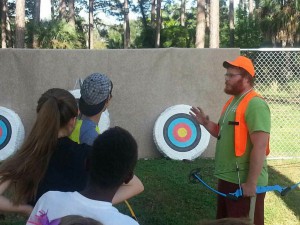by pmdavis | Apr 1, 2016
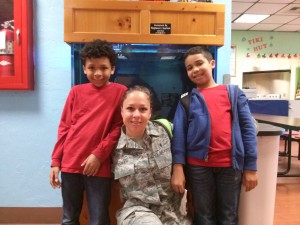
Show military youth that you care- wear purple on April 8th!
April is the Month of The Military Child! When we think of honoring our military, we often think of Memorial Day and Veterans Day. Did you know there is also a time identified to honor our youngest heroes, military children? Since 1986, April has been designated Month of the Military Child. This allows us to honor military children and their families for their commitment and sacrifice. In Florida we have over 51,000 military youth who deal with situations like having their parents in harm’s way when they deploy. Most people think of the color green when they think of 4-H, but on April 8th, 4-H youth and volunteers in Florida will be sporting the color purple to show support for our military families.
Imagine if someone close to you were deployed. Would you like to see all the news reports showing bombs exploding and people shooting at each other? How would you feel about having long and repeated separations when your parent misses important events like birthdays, holidays, school and sporting events? Would you like it if your family had frequent relocations/moves? Every time families move, children have to make new friends, get used to new schools, and find new 4-H clubs and teams to join.
A lot of military children take these changes in stride and some even thrive on them, but it is also hard – kids have to rebuild their world every time they move. UF/IFAS Extension and 4-H are proud to be a part of the military family working with youth centers across the nation to have some consistency for youth in these situations and who are making these moves.
Here locally we want you to join us in showing your support and to celebrate our young heroes! Participate in the 6th annual Purple Up! For Military Kids. Wear purple on Friday, April 8th, as a visible way to show support and thank military children for their strength and sacrifices. Why purple? Purple is the color that symbolizes all branches of the military, as it is the combination of Army green, Coast Guard blue, Air Force blue, Marine red and Navy blue.
The goal is for our military youth to see the support of their community. Please join us in honoring these young heroes as we Purple Up! For Military Kids on April 8th! Be creative….the goal is for military youth to see the support in their school, youth groups, and the community! If you don’t have or own a purple shirt wear a purple ribbon, tie, headband etc. Just show your support and let our youth know we care about them! Can’t make the 8th then do something another day in April. We would like to encourage you to take pictures of your group wearing purple and share them on social media. If you are willing to share then e-mail them to us.:bay@ifas.ufl.edu or post photos to Facebook and tag us https://www.facebook.com/bayifas/ or comment and add your photo.
by pmdavis | Feb 5, 2016
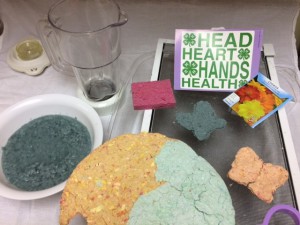
Grow Card Supplies and products
4-H literally got its start with gardening. The very first 4-H Clubs focused on growing tomatoes and corn for boys and canning for girls. Many youth and volunteers still enjoy gardening projects today. One great curricula that is used is the Junior Master Gardening Program. This program allows youth to enhance their life using gardening as the spark of interest. Gardening enriches youth’s lives, promotes good health, gives a sense of environmental awareness and saves money.
One of the activities I enjoy doing with youth combines gardening with recycling and crafting. As a group we will make our own paper grow cards or ornaments that have seeds embedded in them. Once the cards are dry, we deliver them as a service project. The cards are fun and inexpensive to make and are a perfect activity for your next club meeting! Try making them as valentines for Valentines Day. For beginners, we recommend growing tomatoes, lettuce, peppers, cucumbers, basil, chives, or parsley. Not into vegies? Try starting marigolds, cosmos, sunflowers, zinnias, pansies, or petunias.
Download our detailed factsheet with photos and directions. This activity is great for any occasion when you need a card or small gift. You can use as party favors by making them into ornaments using raffia to hang them from a tree or gift bag. You can take them to a nursing home, veterans center, hospital or other site as a service project for your club. Just be sure to share with the individual that they need to plant your card or ornament. It is a great way to help youth share their joy of gardening with others.
Other Extension gardening resources include:
• Florida Vegetable Gardening Guide
If you have a green thumb, consider going “totally green” as a 4-H gardening volunteer! 4-H needs caring adults like you to share their knowledge and passion for gardening with the next generation. Through the 4-H gardening project, youth not only learn gardening knowledge and skills, they also learn responsibility, teamwork, and other life skills that will help them grow up to be compassionate and competent citizens. To get involved, contact your local UF IFAS Extension Office, or visit Florida 4-H.
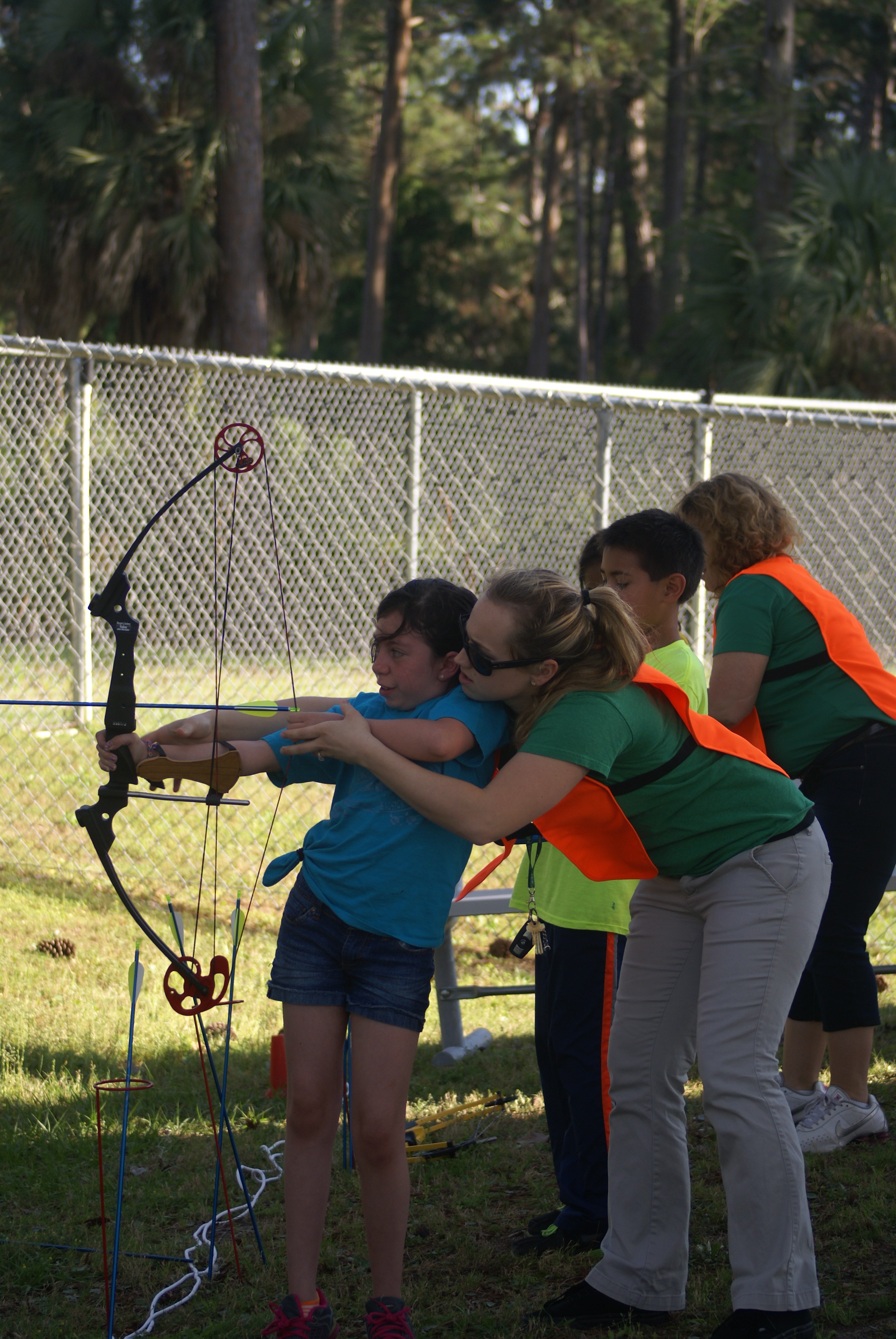
by pmdavis | Apr 16, 2015
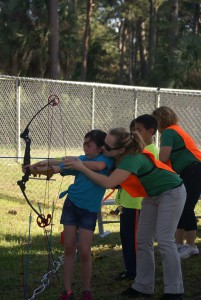
Volunteers insure that military youth have a consistent, quality 4-H experience.
April is the Month of the Military Child, and no Volunteer Appreciation Celebration would be complete without acknowledging our 4-H military volunteers. The team of volunteers and staff at the Naval Support Activity Youth Center in Panama City ensure that military youth have an opportunity to participate in a wide variety of 4-H Programs at their youth center. One of the newest programs they offer is the 4-H shooting sports project. The leadership team for this 4-H club include Ms. Alana, Mr. Cole, Ms. Heather, Ms. Jessica, Ms. Shelby and Ms. Tammy. To allow all interested youth to participate, they started multiple archery clubs that meet weekly helping new archers develop strength, accuracy, and discipline. A small competitive traveling team has also been organized to help youth improve their skills and potential of becoming competitive archers through their 4-H learning experiences.
Cole is a five year veteran 4-H volunteer who did not grow up in 4-H, but was drawn into the program by the opportunity to teach youth life and workface related skills through projects like archery, aerospace, film making, photography, outdoor cookery, robotics and rocketry. His favorite 4-H experience so far has been with the rocketry project: “The youth just really got into it! We learned about force, drag and flight. It was a unified project where everyone became involved and the learning just exploded. They were learning physics, science, and communication skills all at once. 4-H can really make a difference and cause youth to consider different careers too. It is really nice when you see a child that may be struggling in a different part of their life find their niche during one of the 4-H projects. You just see their confidence sky rocket and then carry over into their social confidence also.”
When talking with him recently he said that “4-H is conducive to relationship building while learning life skills allowing both youth and myself to grow. It gives us an organized meeting time with specific goals and direction allowing us to maximize our time and growth. It helps make a difference because it is the conduit running in the background to allow everything to happen. 4-H allows the flexibility of being able to try ideas, experience things and make their curricula work for my needs. The best part is that when youth leave here they have something consistent to look forward to at their next duty station. It provides youth with one consistent thing to look forward to. I feel like we are literally planting the seeds to help youth develop their life skills. The program is nationwide and can help with the many changes and challenges our youth face. We are an important cog in the wheel for navy youth.”
Cole offers advice for anyone thinking about working with 4-H and kids. “If you have even an inkling that you would enjoy working with youth, then do so! It can be very valuable to that child, to know someone cares about them. Your follow through with one child can make a great deal of difference in their life and be the encouragement they need to become something great. Quite often there are not enough role models and caring adults for today’s children. Take the 4-H challenge and help a kid today!”
Dr. Paula Davis, the Bay County 4-H Agent says, “I want to recognize that this 4-H club is truly a team effort. With so many youth involved, it definitely can’t be done with one just person. I really appreciate the teams diligence, enthusiasm, and willingness to try new things with 4-H. The quality of a youth’s 4-H experience to a large extent depends on the relationship built between the 4-H members and their volunteer leaders, and these are some of the best!”
Do you have a passion or expertise that you would like to pass on to the next generation? Consider becoming a 4-H volunteer- we offer a wide variety of opportunities to fit your interests and schedule. Contact your local UF IFAS Extension Office or visit http://florida4h.org/volunteers.
by pmdavis | Apr 8, 2015
Most people think of the color green when they think of 4-H, but on April 10th, 4-H youth and volunteers in Florida will be sporting the color purple to show support for our military families. When we think of honoring our military, we often think of Memorial Day and Veterans Day. Did you know there is also a time identified to honor military children? Since 1986, April has been designated Month of the Military Child. This allows us to honor military children for their commitment and sacrifice. Here in the Florida Panhandle we have over 27,800 military youth who deal with situations like having their parents in harm’s way when they deploy.
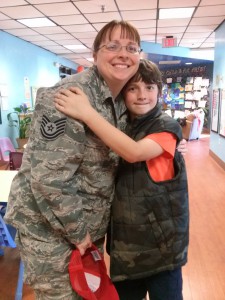
Imagine if someone close to you were deployed. Would you like to see all the news reports showing bombs exploding and people shooting at each other? How would you feel about having long and repeated separations when your parent misses important events like birthdays, holidays, school and sporting events? Would you like it if your family had frequent relocations/moves? Every time families move, children have to make new friends, get used to new schools, and find new 4-H clubs and teams to join.
A lot of military children take these changes in stride and some even thrive on them, but it is hard also – kids have to rebuild their world every time they move. UF/IFAS Extension and 4-H are proud to be a part of the military family working with youth centers across the nation to have some consistency for youth in these situations and who are making these moves. Here locally we want you to join us in showing your support.
So what can you do to show them that we appreciate their sacrifices?
1. Participate in the 4th annual Purple Up! For Military Kids. Wear purple on Friday, April 10th, as a visible way to show support and thank military children for their strength and sacrifices. Why purple? Purple is the color that symbolizes all branches of the military, as it is the combination of Army green, Coast Guard blue, Air Force blue, Marine red and Navy blue.
2. Ask others to Purple Up! We hope everyone will take this opportunity to appreciate and celebrate these young heroes and to thank military families for their support and the freedoms they provide us by their service and sacrifices. Here are a few ideas:
- Ask your local, regional, state, and federal officials to wear purple on April 10th

- Engage fraternal organizations, social clubs, and Rotary groups
- Request local businesses to post a Purple Up! message on their roadside signs
- Ask stores and restaurants to put a Purple Up! flyer in their business window
- Suggest companies and businesses ask their employees to wear purple
- Invite coworkers, as well as members of your spiritual community, exercise class, or golf league to join you in showing support for the military youth in your town by wearing purple on April 10th.
For more information, contact Paula Davis, Ed.D. at the Bay County Extension Office at 850-784-6105. All programs are open to all persons regardless of race, color, age, sex, handicap or national origin.
by pmdavis | Apr 3, 2015

Dying eggs with natural materials is a fun 4-H club activity that teaches a little science too!
This time of year, many children are egg-cited to dye Easter Eggs! This year, instead of buying a kit to dye eggs, why not use natural materials that you most likely already have in your kitchen or yard? One 4-H Junior Master Gardener Project teaches young gardeners how to make dyes made from plant parts and other natural materials and teach a little science at the same time.
Start by cleaning the eggs by wiping them with vinegar. Why vinegar? Well there is a little science behind that…and a great teachable moment! The shell is protected by a thin layer of protein molecules called the cuticle. This cuticle has a neutral charge so not much is attracted to it. The vinegar contains acetic acid, which reacts to make the cuticle positively charged. The dye typically has a negative charge. So to get the dye to “stick” to the egg, the positive charge on the cuticle attracts the negative charge of the dye. (Use a magnet as a visual example.) Therefore the acid is needed to make the color adhere to the shell. FYI! If the egg is left in the acid it will make the shell disappear. (A great experiment for another day)
Back to dyes…Talk to youth about how early Americans made their own dyes. Look around your house to see what might make a good dye and predict what color it will make setting up your own mini science experiment. To make your dyes mix 1-4 cups of plant material or 2 to 4 tablespoons of ground herbs or spices with 1-2 quarts of water in a pot. Bring the mixture to a boil, turn off and steep until cool. Strain, keep liquid and discard plant materials. Juices can be used as is. Soak eggs in the liquid/juice dyes + 1 teaspoon of vinegar – the longer soaked the brighter. If soaking eggs for extended periods, store eggs with dye in the refrigerator. Easter eggs are safe if handled properly. They must not be out of the refrigerator for more than 2 hours.
Ideas for dyes:
- Blue to Purple– grape juice, red grapes, blueberries, red cabbage, blackberries
- Reddish Pink Purple– paprika, red onion skins; beets/beet juice, Cranberries, Hibiscus Flowers, Red teas (Passion, Hibiscus)
- Brown– coffee, black tea
- Golden Orange– yellow onion skins
- Orange– turmeric, ground cumin, yellow onionskins plus beet juice, paprika Green– spinach, kale, parsley, carrot tops.
- Yellow– curry powder, orange and lemon peels, Safflower Petals
For cool effects before cooking/dyeing:
- Draw on your egg with crayons
- Wrap your egg with rubber bands or yarn for a tie-dyed effect
- For a marbled effect, put 1 Tbsp oil in the dye before dropping your egg in
- Stamp your eggs with nature images by placing a leaf or flower on your egg, then wrapping it tightly with a piece of nylon stocking. Dip into dye. When you remove your egg from the dye, carefully remove wrappings.
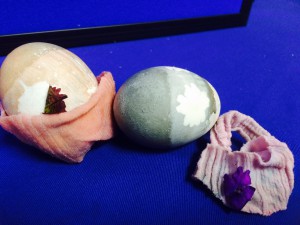
Use leaves or flowers to make interesting prints on your eggs.
Cool effects after cooking/dyeing:
- Sprinkle with salt while still wet and see what pattern emerges!
- For a mottled egg, rub/pat it with paper towel as soon as you remove it from the dye
- Draw with markers when your egg is dry
- To make your eggs gleam, rub vegetable oil on egg after cooled and dried.
These and other activities are part of 4-H, one of the nation’s most diverse organizations. 4-H includes people from all economic, racial, social, political, and geographic categories. There are no barriers to participation by any young person. Participants are given the opportunity to engage in activities that hold their personal interest, while being guided by caring and trained adult volunteers. For more information about joining 4-H as a youth or volunteer, contact your local UF/IFAS Extension Office or visit http://florida4h.org.





